_______________
Yoshua Okón Oríllese a la Orilla, 1999-2000
‘For his multichannel video installation, Okón bribed policemen to perform in front of his video camera, exposing the blatancy of their willingness to put more pesos into their pockets. The resulting videos feature, among other things, a couple of cops following an unseen dancer, trying to synchronize their dance steps to a silly tune; another pair telling knock-knock jokes; and a disturbing character displaying his prowess at waving his nightstick, boastfully grabbing his crotch every so often.’
_______________
Zhao Zhao Broken Officer, 2018
‘Zhao was supposed to show later this year in New York with dealer Christophe Mao (presumably at Chambers Fine Art, where the artist has exhibited before) but rather than ship his work to the US, Chinese customs police instead confiscated it. The work consisted of deliberately broken pieces of a monumental concrete sculpture of a police officer. Not only did the government confiscate Zhao’s art, however; it also slapped him with a 300,000 yuan fine (roughly $48,000) for no apparent reason. Authorities tell Zhao that even if he pays — which he says he would like to but currently can’t afford to do — he won’t get his art back. They’ll let him see it once more, and then they’ll destroy it.’

_______________
Duane Hanson Policeman and Rioter, 1967
bronze, acrylic enamel, textile, and mixed media
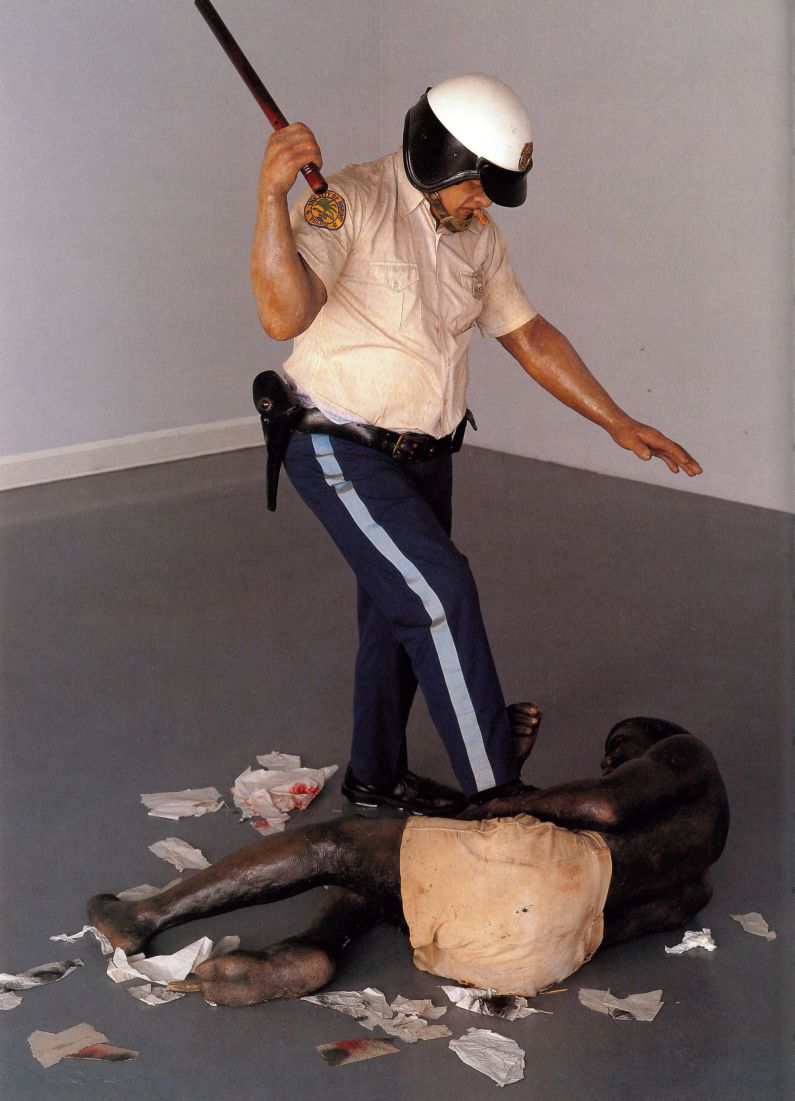
_______________
Ghoulish Gary Pullin The Madness of William Lustig, 2017
‘Created to commemorate a screening of six Lustig films (Maniac, Maniac Cop 1, 2, 3, Vendetta, Hit List) at the Yerba Buena Center for the Arts in San Francisco CA.’

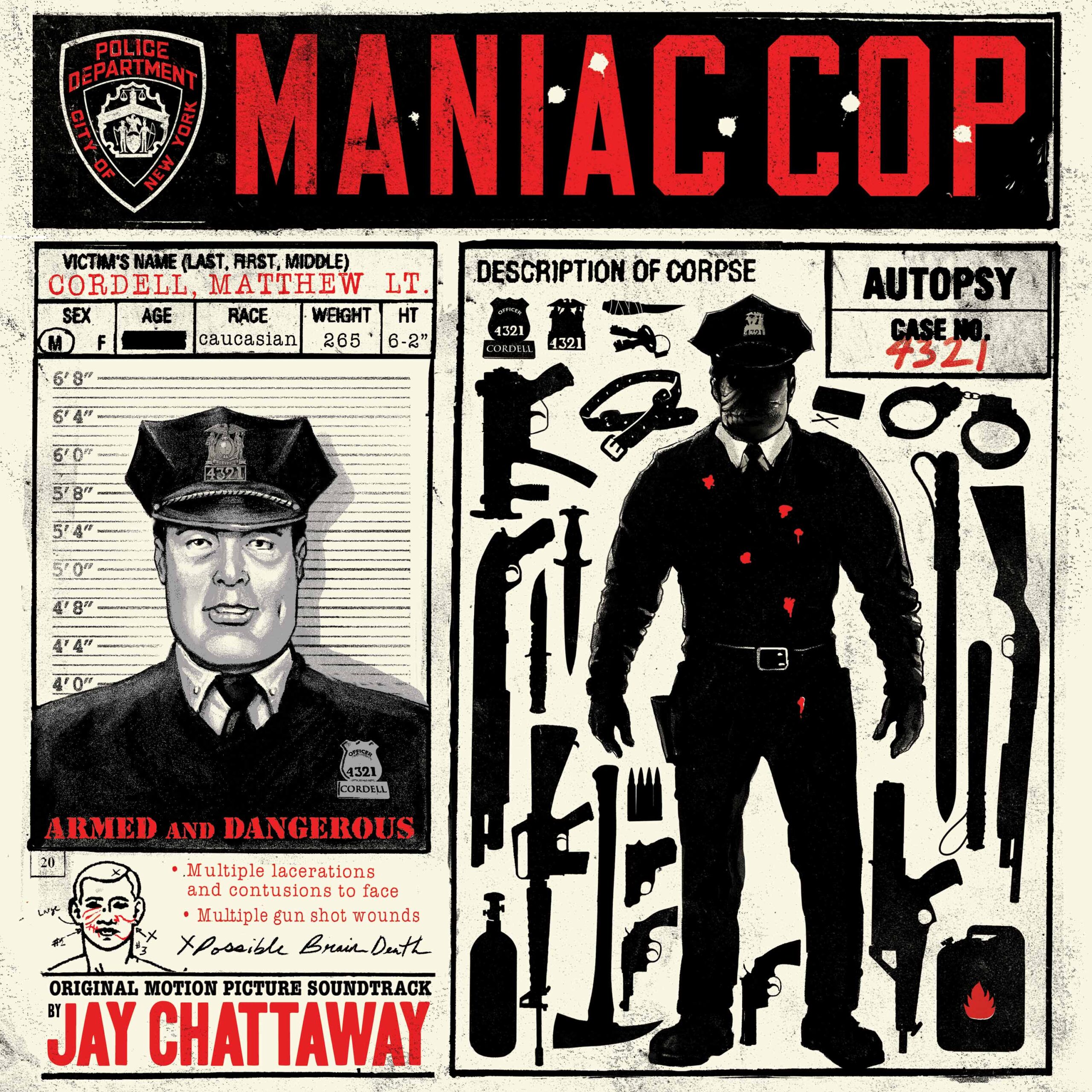
_______________
Seward Johnson Untitled, 2000
‘The statue was erected in the year 2000 by the Village of Friendship Heights. The statue depicts and honors longtime Friendship Heights resident Colonel James S. McAuliffe Sr., who was a police officer for 42 years, and the Montgomery County Police Chief for 16 years. The bronze statue faces towards the intersection of South Park Avenue and The Hills Plaza. It also serves as an excellent reminder for passing vehicles to stop for pedestrians at the crosswalk.’

_______________
Weegee Booked on Suspicion of Killing a Policeman, 1941
Gelatin silver print

_______________
Kelley Walker Black Star Press (rotated 90 degrees), Press, Black Star, 2005
‘Kelley Walker’s artwork uses advertising and appropriated images to comment on politics, violence, and consumer culture. In Black Star Press (rotated 90 degrees counterclockwise); Press, Black Star, Walker manipulates an iconic Civil Rights–era image taken by the photojournalist Charles Moore for the photographic agency Black Star. Instead of simply replicating the photograph, Walker rotates it and overlays portions of the silkscreened image with chocolate.’


______________
Tony Cragg Riot, 1987
‘Assembled from a multitude of meticulously positioned plastic objects, which span the entire width of a wall, Riot conveys a barricade of police officers wearing special protective gear. Following Cragg’s enduring interest in the dynamic power of matter to assume form, the wall work figuratively foregrounds a scene of militarized state power, alluding to the many social upheavals that arose in reaction to the conservative Thatcherite regime in 1980s Britain.’
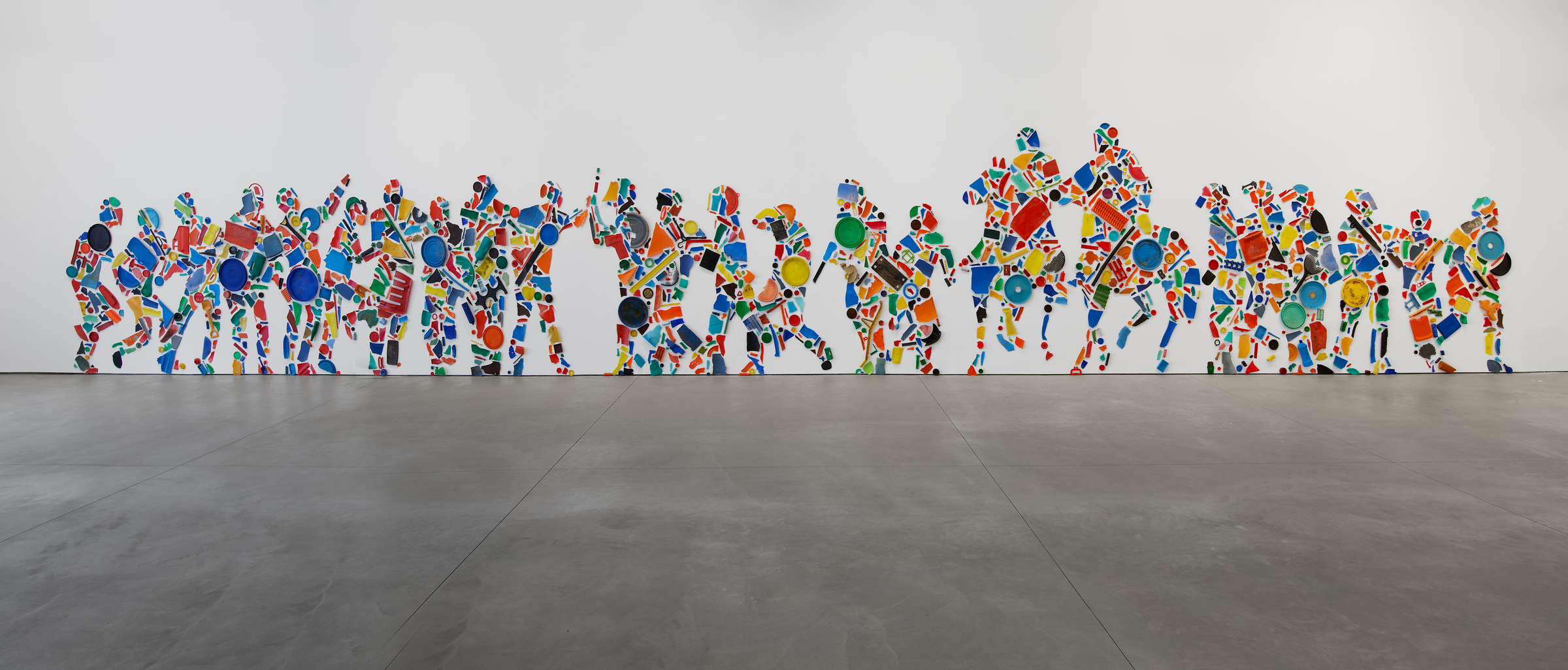

______________
Randy West Reclining cop on motorcycle, 1981
‘Randy was a San Francisco -based artist who created images mainly for books and magazines such as Drummer. With his partner, David Lindsey, they founded West Graphics, a popular LGBT greeting card company.’

_______________
Jean Michel Basquiat La Hara, 1981
‘With La Hara we find a white person depicted as a skeleton with a menacing presence. Normally the artist would not produce portraits of white people, but might refer to them through lettering within other paintings. The reference is believed to have been to a police officer, and Basquiat would regularly speak out against the organisation which he felt was responsible for oppressing his own community, particularly within New York. His title for this piece is a strange fusion of Irish surnames, relating to the police, and also his own Puerto-Rican culture which together produced the term La Hara, which no-one would have been able to work out without the later explanation by the artist. One can, however, make some visual connections by comparing this artwork with themes used in some of his other paintings.’

_______________
Marc Fischer Killed by Police and A Cop Kills a Student, 2016
‘Marc Fischer, known internationally for his work under the name Public Collectors, as well as with the collective Temporary Services, contributed two stacks of free posters. One, titled A Cop Kills a Student…, shows police officer Robert Rialmo’s face and describes the killing and the lawsuit, while the other, Killed by Police, features a photo of and text about Bettie Jones, the unarmed neighbor who was accidentally killed when Rialmo shot at the mentally ill bat-wielding teenager, Quintonio LeGrier.’
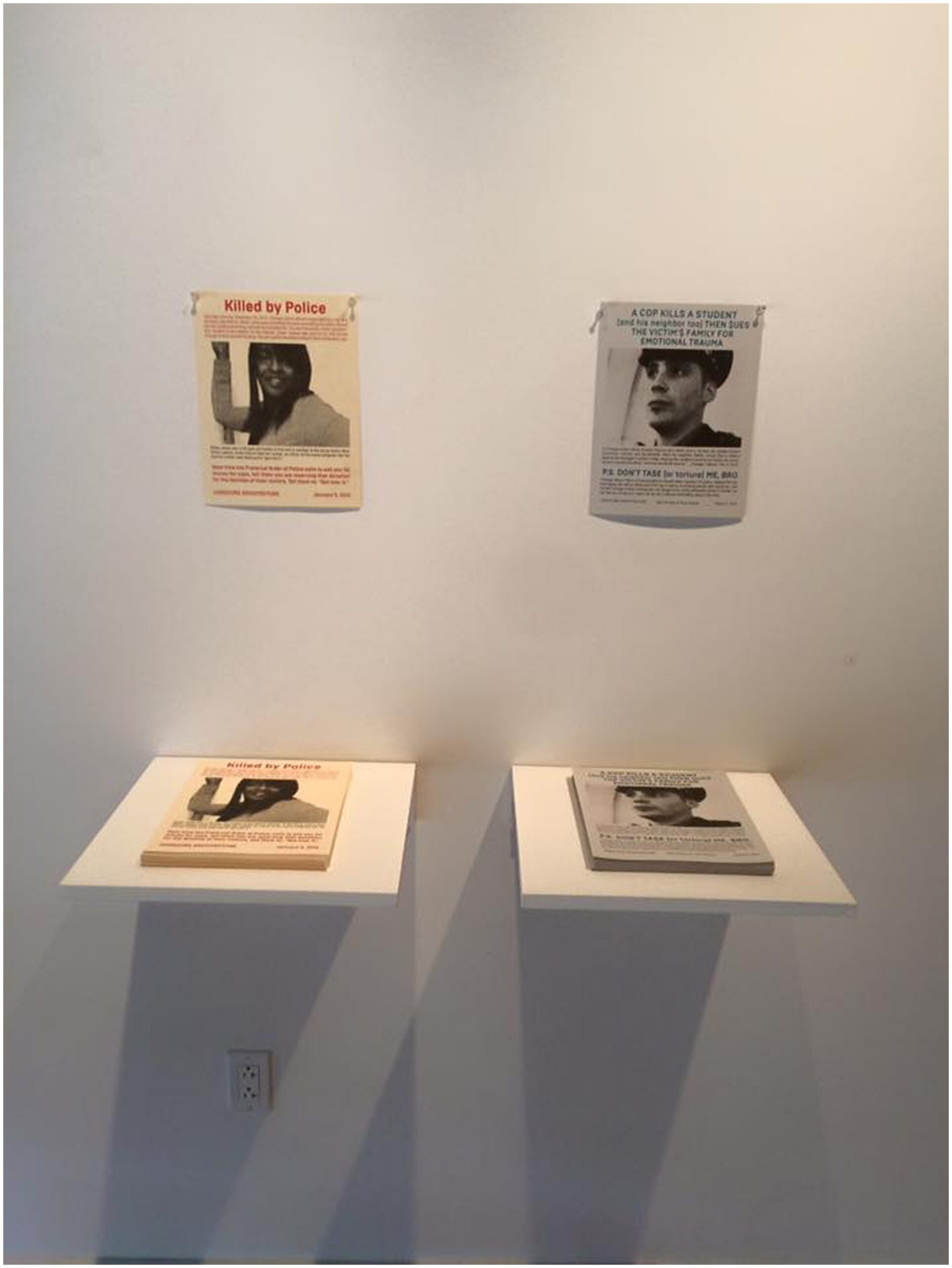
______________
Marcel Walldorf Petra, 2011
‘The German police have their panties in a bunch over a highly inflammatory sculpture of a urinating policewoman by artist Marcel Walldorf. Entitled “Petra”, the hyperrealistic figure depicts a female officer crouched, peeing with buttocks exposed. The most chilling detail is her riot baton casually propped on the wall next to her. Saxony interior minister Markus Ulbig, who is responsible for the state’s security services, told the German press he was shocked by the sculpture, which he branded an insult to police officers. The GdP police union also blasted the piece, saying ‘it breached the limits of artistic freedom.'”‘

______________
Donald Lipski Let Love Endure, 2021
‘The sculpture is studded in over 1,400 actual police badges all given the number 2020 to remind us of this historic year, which like 1776 will be regarded as a pivotal time in our history, given the police slaying of George Floyd and so many other people of color. 2020 was also the 150th anniversary of the 15th Amendment, which granted Black men the right to vote, and the 100th anniversary of the 19th Amendment, which granted women the right to vote.’

______________
Mike Lroy Don’t Shoot, 2016
‘Quite large in size, “Don’t Shoot” was created with acrylic and spray paint on canvas. Built upon a bold cardinal background that’s somewhere between the color of fresh blood and Badger red, it features a trio of police officers decked out in riot gear, two of whom are wielding what look like tactical shotguns and the other a plastic shield, all facing towards a young African American child who is pointing a Super Soaker-style water gun. The cops are presented in a Banksy-style black-and-white stencil form, while the kid is painted in color. On the morning of May 1, the WPPA and its executive director Jim Palmer released a statement about “Don’t Shoot.” Co-signed by the Madison Professional Police Officers Association, it was titled “Police Groups Issue Statement in Response to Anti-Cop Public Library Display.” Basically, the unions took exception to the depiction of the officers in the painting, and criticized the library system for exhibiting it. It went on to chastise the library’s display as an “ill-conceived promotion” and the painting itself as presenting a “biased and hostile view.”’

_______________
Bod Mellor Police Constable Kate McFay (Maxine Peake), 2016
‘This particular painting is a portrait of the actress Maxine Peake playing Police Constable Kate McFay, the central character from a one-off television comedy drama called Bike Squad that aired on ITV in 2007. The painting depicts Peake dressed in a white shirt, black jacket and high visibility police vest, as well as a police bicycle helmet. In her right hand she holds an extended police truncheon. She is submerged to her chest in white foaming water on which five severed fingers sit, and in the foreground is a waterfall and rockface. Her face is obscured by a bright red net; one eye is heavily made up while the other is left bare. Protruding from her mouth is a brown finger.’
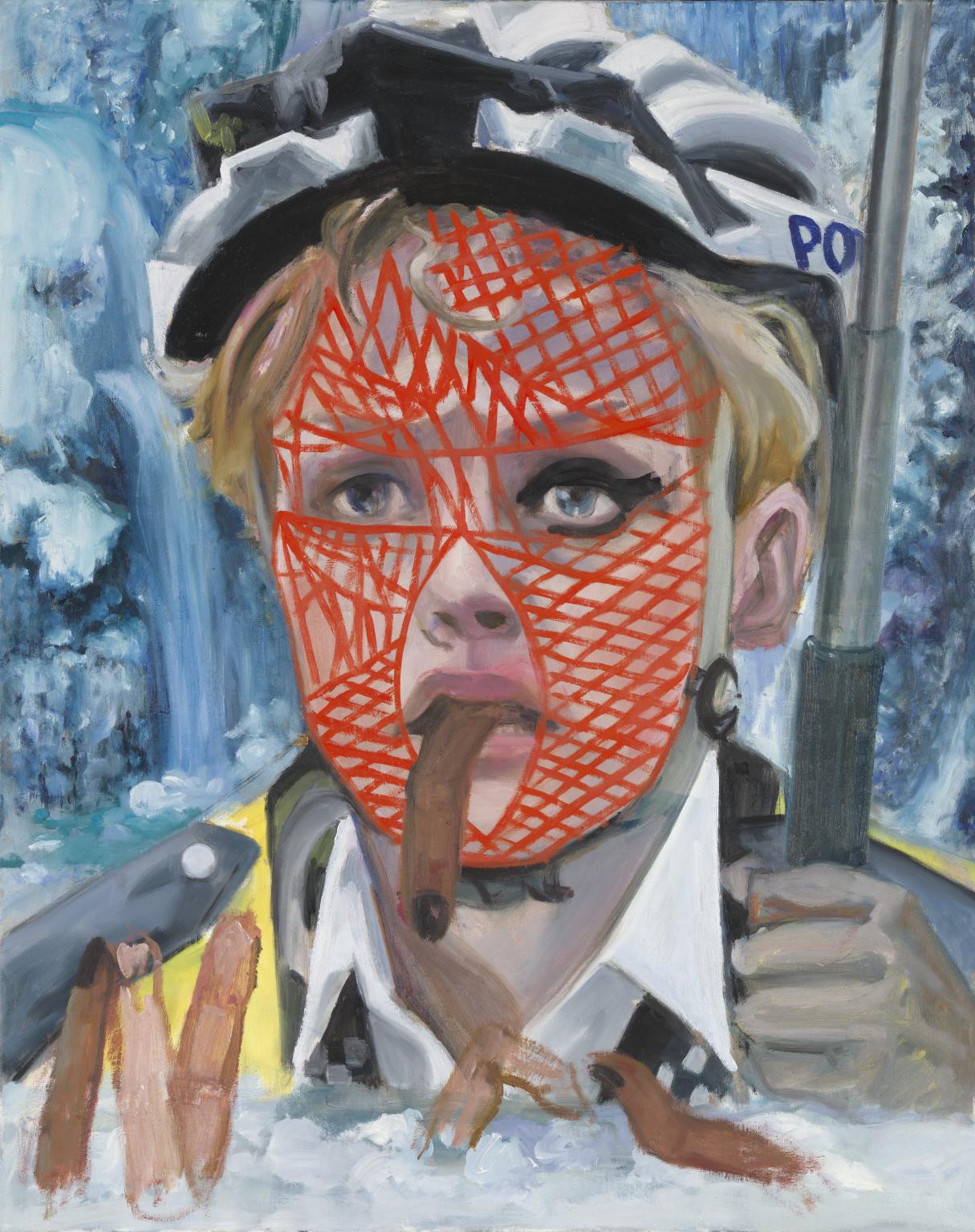
_______________
Ramón Miranda Beltrán to articulate fear set a cop free with love for Cady Noland, 2015
Photo transfers and framed targets


______________
Robert Longo Riot cops, 2017
Charcoal on monochrome palette
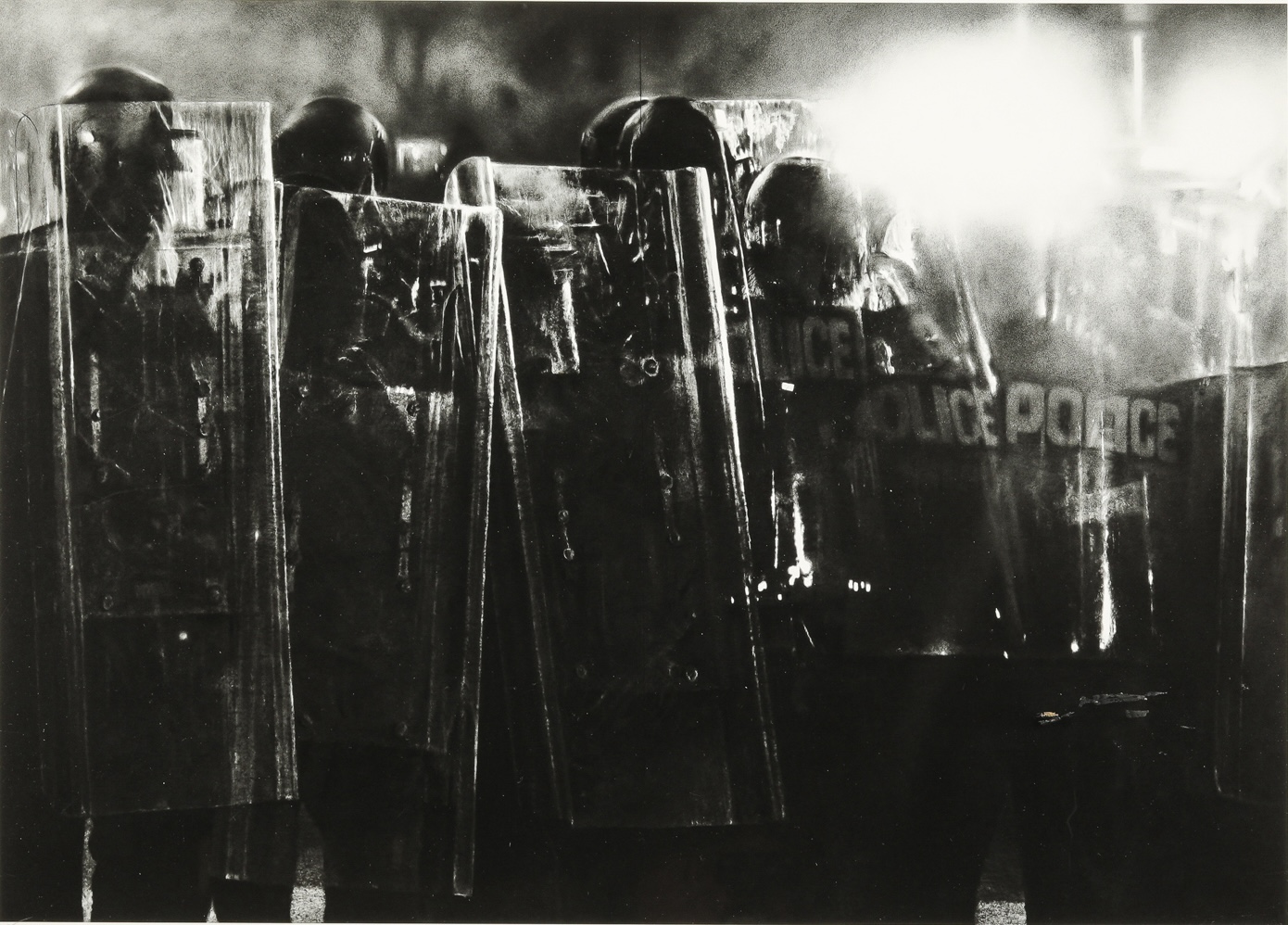
______________
David Humphrey Arms of the Law, 2020
‘Some of these works fuse militarized police with neutralized citizens into a monstrous hybrid, a dynamic liquid whole in a space littered with trash and painterly affect.”’
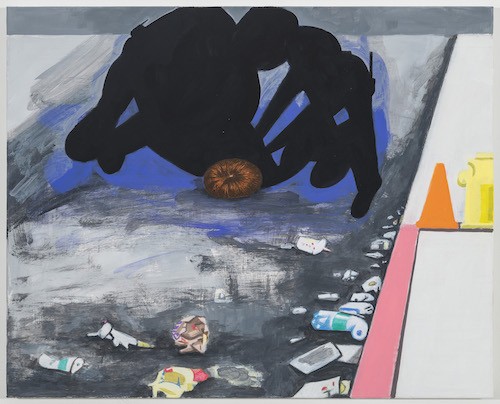
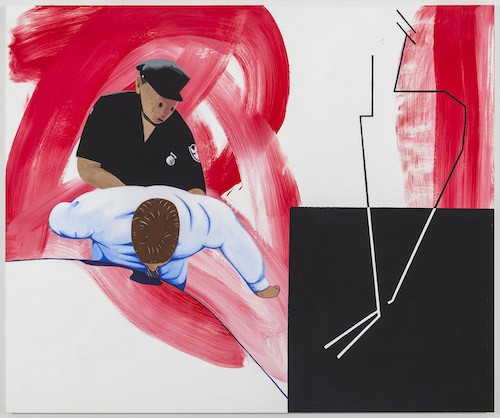
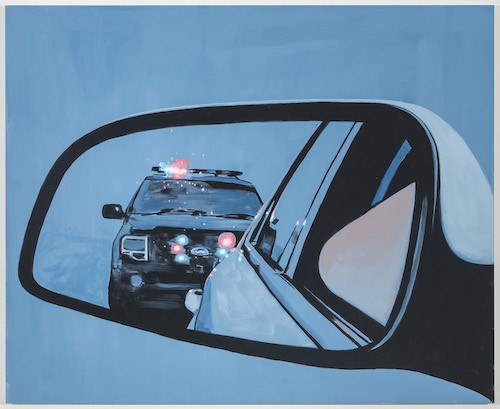
______________
Nicolas Winding Refn Too Old to Die Young, 2019
‘The series, which Refn actually considers to be a film, languidly follows a dirty cop, a Mexican crime boss who lives for anal sex and avenging his mother, a social worker who moonlights as a hit woman/mystic, and the High Priestess of Death, who metes out justice on behalf of abused women.’

______________
Yiannis Psychopedis La manifestation/Scènes de rue, 1968
Acrylic on paper

______________
Liu Bolin Civilian and Policeman, 2006
Photography: pigment ink

______________
Maurizio Cattelan Frank and Jamie, 2002
Polyester resin, wax, pigment, human hair, clothing, shoes and accessories

______________
Jill Freedman Street Cops, 1978-1981
‘Photographer Jill Freedman (1939 to 2019) was there to capture the good, bad and the ugly of New York City during the 1970s and ’80s. With unprecedented access to two NYPD’s precincts – Midtown South of Times Square and Penn Station, and the Ninth Precinct of the East Village – Freedman was there when police made arrests, engaged with communities, and to document the camaraderie among cops. ‘I set out to deglamorize violence,’ Freedman once said.’




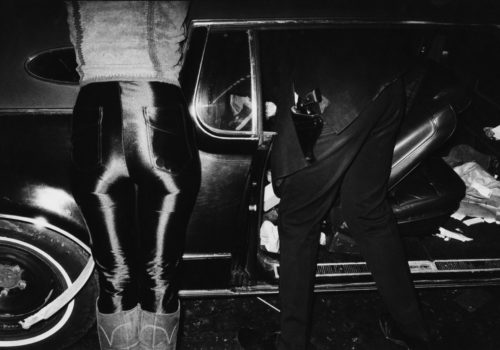



______________
Jay Rechsteiner Approximately 50 LAPD officers, most of them drunk, are beating up six prisoners on Christmas morning. The beating lasts 95 minutes, 2022
Acrylic on canvas
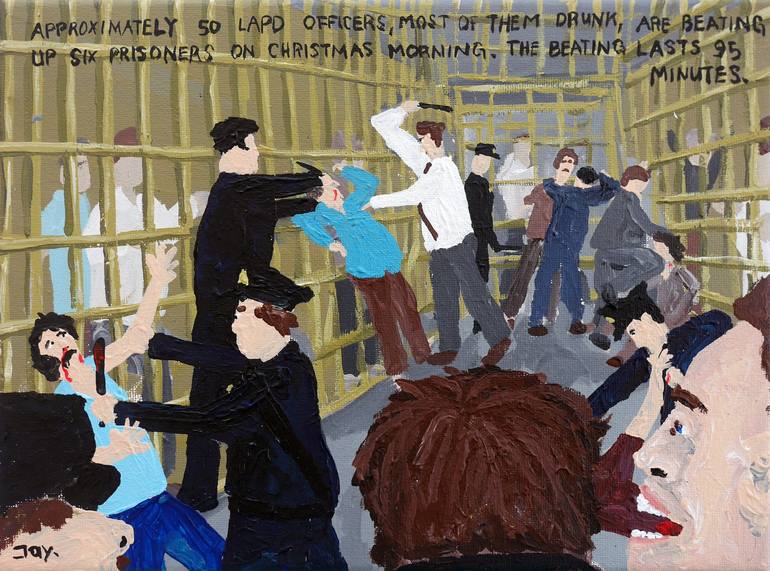
______________
Amado M. Peña, Jr. Aquellos que han muerto, 1975
‘The title of the print, which translates into “Those Who Have Died,” immediately foregrounds the theme of death. Santos Rodriguez was a twelve-year-old boy living in Dallas, Texas, in 1973 when he and his brother were accused of allegedly stealing eight dollars from a vending machine. Early one morning, police officers took them in for questioning. While they were seated handcuffed in a police car, one of the officers tried to coerce a confession from Santos by playing Russian roulette. He fired his weapon once and nothing happened. He fired his weapon again and killed the boy instantly. The Mexican American community of Dallas erupted in protest, demanding justice for Santos. Years later, President Jimmy Carter wrote to the boy’s mother expressing his condolences after the Justice Department refused to file civil rights charges against the officer.’

______________
Peter Bernal A Policeman Disgusted with Himself, 2016
oil color, acrylic color, plaster, PVA glue, cellulose pulp and wire
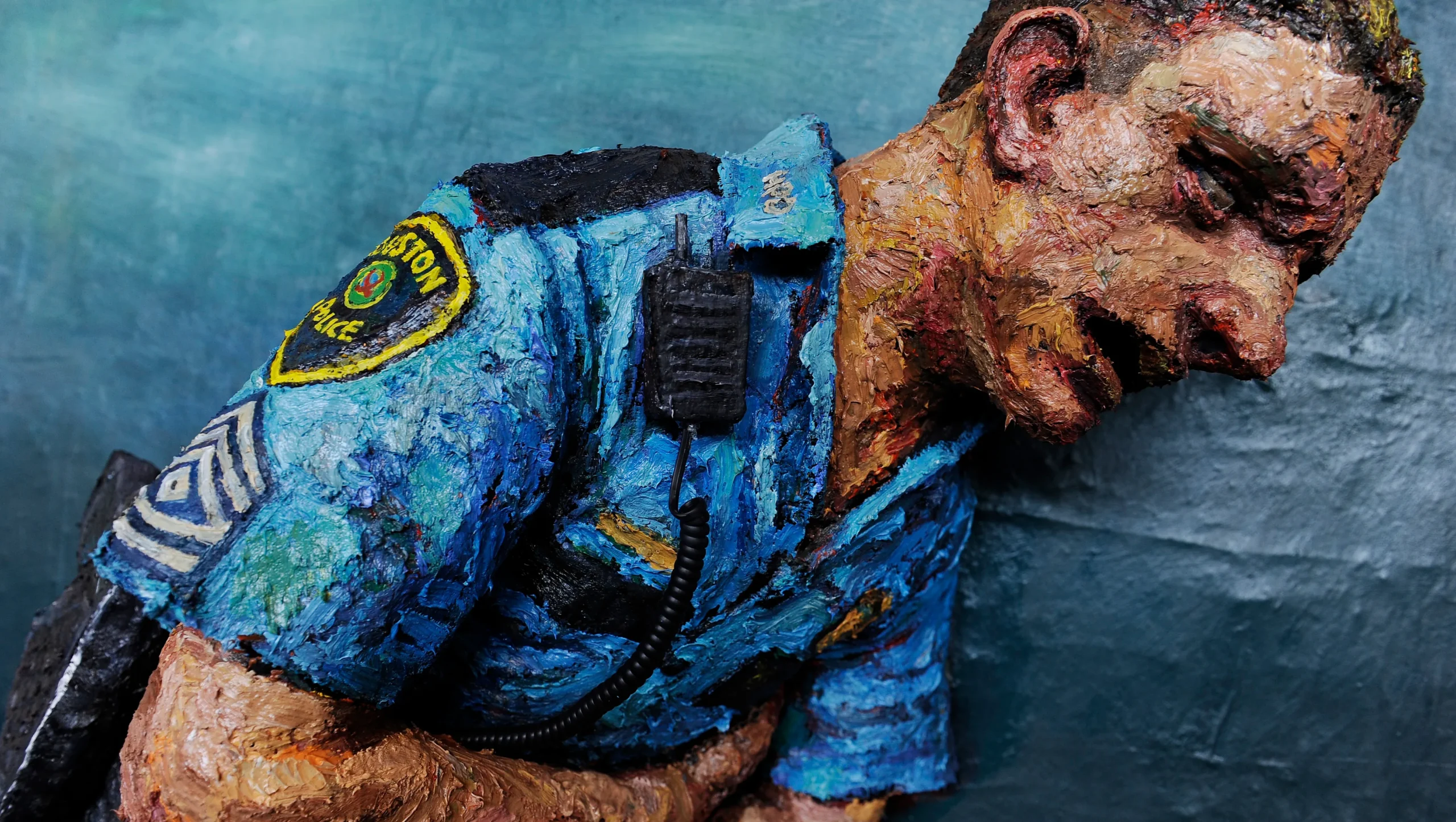
______________
Gordon Bennett Ask a Policeman, 1993
Etching on paper

______________
OG Slick Three Slick Pigs, 2022
‘A new exhibition at the California Center for the Arts in Escondido (CCAE) showcases artwork that represents the diverse cultural landscape of Southern California, but one piece is receiving heavy criticism. The piece is titled “Three Slick Pigs” and was created by a Los Angeles based artist who goes by OG Slick. In a statement, OG Slick said the acronym A.P.A.B is taken from the term ACAB (“All Cops Are Bastards”). On Sunday, former Escondido Chief of Police, Ed Varso told the Escondido Times Advocate: “I am extremely disappointed to learn about the art piece depicting insulting images of honorable police officers. The paper also quoted Escondido Mayor Paul McNamara as saying he was impressed by many things at the exhibit, but “was extremely disappointed and angered by one exhibit depicting the police as pigs. I found the exhibit incredibly disrespectful.” McNamara also questioned whether the CCAE has “the right leadership … and should the council reimagine how this city asset is managed?”’

______________
Turbosquid NYPD Caucasian Police Officer T-Pose, 2023
‘NYPD Police Officer T-Pose is a high quality, photo real 3d model that will enhance detail and realism to any of your rendering projects. The model has a fully textured, detailed design that allows for close-up renders, and was originally modeled in 3ds Max 2012 and rendered with V-Ray. Renders have no postprocessing. Hope you like it!’

*
p.s. Hey. ** _Black_Acrylic, Oh, my utter pleasure, Ben. That gig last night sounds fun. How did the magician thing play onto it? No problem if that’s too hard to characterise without a visual. ** Misanthrope, Naming things can be good. I know when I’m writing something and I give it a title it gets serious. I probably would have indulged heavily in alcohol when I was younger if it hadn’t just slowed me down. I don’t like slowing down. Life’s too short. ** Даrву📺, So … you got it? The permit? Someone should do that post you proposed. I’m not versed enough, I don’t think. A friend of mine for while lived in the apartment in Santa Monica where Tim Buckley died. Actually, he died walking up the building’s external staircase, but he was heading home. I’ve taken K, but I didn’t feel like I was a hole, so maybe … not? Oh, wait, update, you passed! Whoo! How soon can you use it? Congrats! The world is a little more open now. ** Dominik, Hi!!! Yes, yes, I will. I’m like the opposite in the sense that I generally do nothing but stuff my body with healthy food, so when I see junk food it’s like being offered cocaine or something. I should say that being offered cocaine is a bit of a fantasy because it’s kind of the only drug left that I think I’d be hard pressed to turn down. I’ve scribbled love’s question mark sentence down as a possible first line in a future poem. Enjoy the days with A’s folks. Did you get up to lots of fun? Love teaching every cop to talk like Black Metal singers sing, G. ** Harper, Hi. I’m glad you came back. I’m really easy to talk with. Almost everybody says so. I’m happy the blog got you into those writers, and, yeah, Welch and Bowles are biggies for me too. Huh, yeah, okay, I get the ‘until you’re published’ thing, or if that helps you work. I did call myself an ‘aspiring writer’ for a long time even though I was writing as hard at the time as I do now. How is the school, I mean in the sense of helping your writing? Is it a good program? I quit university after one year, so studying writing is kind of interesting and exotic to me. Happy Friday. ** SP, Hi. Thank you. I’d never heard of the City Girls until you mentioned them. But now I have their stuff bookmarked for my indulgence. I like hiphop. It doesn’t seem to be, like, an immediate go-to genre for me. I seem to listen to more fringe, experimental hiphop, although I’m blanking on names at the moment. Among known people, I do really like Playboy Carti, or at least his last album, which I was really obsessed with for a while. Can you recommend some things for me to try out? Have a good day yourself, and thanks one more time, and hope to see you again. ** Justin, Hi. That sounds like a very good change. I mean, if you have to cut long hair, that seems like an equally good move. I’m a long hair fan. Maybe because I grew up in the hippie era or something boring like that. I’ve had the same hair and clothing style for forever, so I have to surprise people with what I say or maybe sometime unexpected facial expressions. My day was passable, yours? ** GrOWL, Wow, you’re typing me a postcard. Thanks. Sounds great. The one time I was in Greece it reminded me a lot of Southern California. Same kind of shrubbery and light and things. A kiss back! ** Steve, I sure hope your visit with your parents is the makings of a positive way forward. Everyone, Mr. E has ‘reviewed Med Hondo’s WEST INDIES, which gets re-released in the U.S. on Friday’, which I guess means today, here. ** Toniok, Hi, pal. Thanks for thanking mighty Ben. And thank you about the film. Hopes are high, hopefully not too high. xo. ** Allegra, I will! ‘Paper Mario: The Thousand-Year Door’, which is one of the best, is being rereleased for the Switch in May. But I hear the recent one — the one I’m aimed at — is great too. Oh, right, Keith went to Brown. Did you find being at Brown helpful, interesting? I know so many people who’ve gone there. Most of them look back on it fondly. I will, re: ‘ICR’. Have the best Friday ever. ** Uday, Thanks, but it’s okay. It formed me into whoever I am. Can’t argue with the past, or something. Mewing: no, I just looked it up. If you mean the thing you do with your tongue in your mouth? Huh. Why do you ask? I know Zizek, yes. Not a big fan of Zizek, I have to say. Should I try to view him in a more positive light? You like him/his writing? Sorry about your not great day. Could today have been nice enough that it made yesterday’s bleah no big deal? ** Right. Cops. That says it. See you tomorrow.













 Now available in North America
Now available in North America 